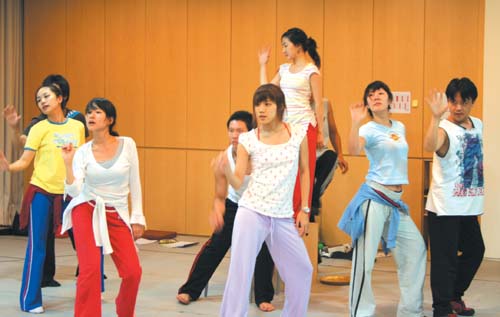
The musical The Play was introduced to the public in 1999 and, unlike most other locally produced musicals, it has been continuously popular among Koreans. Over 170,000 people watched the musical until 2002, and the scenes featuring Gini, the main character who fights back to the computer system for her love and freedom, and Gods, the manager of the computer program, created lasting impressions on viewers.
This year, starting September 1, the musical crew will proudly present a revised version of The Play. Scene one will be a remake of past scenes, while scene two and scene three are newly written episodes. The Play will also be the first and only musical to take part in the digilog trend. Its executive artistic director, Lee Dong-il, who also directed the opening of the 2002 World Cup, is ambitiously hoping to deliver its message through a mixture of technology and traditional acting.
? wanted to combine artistic trends to reflect our daily lives. Digital technology is deeply involved in human lives, as there are so many machines that we rely upon starting with computers, the Internet, cars and more. However, not many try to understand digital trends or think of them as artistic materials. Therefore, I tried to portray this familiar aspect of our daily lives in a new piece of art,?says Lee.
One way The Play incorporates digilog features through the actors?movements is based on three principles of connection, circulation and cross-over. This kind of movement is also named ?OW XYZ.?Sometimes the actors move in circular motions and sometimes their movements are in straight lines. You can clearly recognize this especially in the dance movements. Through these kinds of movements, characters are able to deliver various messages at one time.
The music also has digilog characteristics. Written by Kim Hyun-chul, the singer, songs are not only sung by the actors but also accompanied by computerized voices. This happens when the male protagonist U-chul sings in two voices at the same time. Also, there is a scene where the antagonist Gods sings while he also plays music by hitting buzzers attached to his body.
It is not just the technical aspects of the play that will grab the audiences?attention but also the story itself that is thrilling. The plot is very closely related to our daily lives because it deals about the love of family, importance of smile and laughter, and problems regarding money and power. The Play also communicates through various types of symbolism, especially well-known biblical references, so viewers can easily understand and link emotionally with the characters.
? wanted to tell people that pure agape (selfless love) is harder to find in our society as more people become isolated through technology, addicted to different factors, and constrained by many fears. My intention in all the scenes is to ask people to see through themselves and recognize the fear, constraint, or addiction they may be facing. The overall message is to love and forgive oneself and one another. Through this process, one can truly be free from various fears, addictions, and emotional distress,?says Lee. As a Christian, he has based the story plot on Christian beliefs.
Throughout the play, Lee connects laughter with digilog moments. In the first scene, ?ice Cakes,?passengers are stuck in a situation where their train stops due to a cow that is blocking the railroad. The passengers are hypnotized by Gods that they will lose their laughter if the train starts to move after the cow walks out of the railroad. In the second scene, ? Capella Boy,?U-chul loses his beautiful smile as he becomes more and more influenced by commercialism. In the third scene ? Whale? Tale,?people sell their laughter to earn money for gambling. In this scene, Lee portrays laughter as one of the most important parts of being human, as it symbolizes happiness.
Lee also criticizes the current desires of society through various humorous symbols. In the first scene, people are hypnotized into referring to their most precious things such as mobile phone, lover, appearance, and family as ?ice Cakes,?which is one of the most common things in Korean society. This reference was made to symbolize how humans can be attached to something that is valueless simply by being told that it is valuable. In the third scene, people are gambling to win a whale, which is a symbol of wealth and power. It is humorous to see the characters of the play crying and laughing over the whale or selling their smile for gambling money. However, the scene is intended to highlight the useless waste of the gambling zones now widely spreading in Korea.
Lee successfully delivers his message to the audience through his creative scenes and humorous references. The Play will help you get a better view of the world and yourself. The Play will be shown from September 1, 2006 to February 25, 2007 in the Broadin Art Center.

